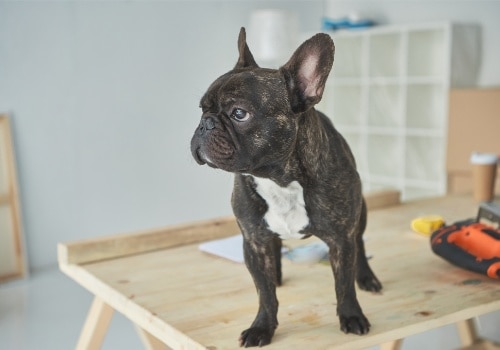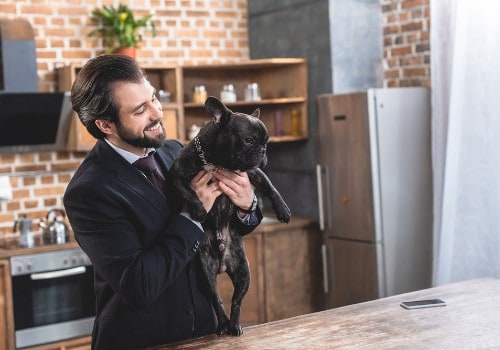Of all the challenges that come with living in an apartment, having a dog may be one of the toughest. But contrary to popular belief, you can keep a dog happy in an apartment — yes, even a small one!
You’ll face some unique obstacles and you’ll have to get creative at times, but it’s easier than you think to make your apartment a puppy paradise.
Here are our top ten tips for giving your dog the best apartment life possible.
10 Easy Ways to Keep Your Dog Happy in an Apartment

1. Choose the Right Breed
We’d love to say that any dog of any breed can be happy in an apartment, but unfortunately, it’s just not true. Certain breeds and temperaments just aren’t compatible with apartment living.
The most obvious factor is size. A 600 square foot apartment may be just the right size for you, but for a Rottweiler or Newfoundland, it will feel more like a cage than a home.
But it’s not just size that matters: temperament does, too. A large dog who’s laid-back and low energy will fare much better in an apartment than a smaller dog who’s constantly running around and bouncing off the walls.
Large breeds like Chow Chows, Tibetan Mastiffs and Great Danes are known for being quite lazy, so they may do well in an apartment setting. But as always, it depends on the individual dog, so you’ll need to get to know the dog you want to adopt before bringing him home.
2. Exercise Your Dog Often
All dogs need regular exercise, but dogs that live in apartments need it even more. After all, they can’t just head out the doggy door and into the yard to run around whenever they want!
It’ll be your responsibility to make sure that your dog gets his daily workouts. If he can’t expend his energy through exercise, he’ll do so in other ways — like destroying your furniture or chewing up your shoes.
Multiple daily walks will be necessary, and you’ll want to make regular trips to the dog park or another place where your dog can really get active. High-intensity exercise not only wears your dog out, it strengthens his muscles and prevents him from becoming obese.
3. Make a Space Just for Your Dog
It can be tough to arrange your apartment in such a way that everything has its place. But it’s important for your dog’s well-being that he has his own space that he can access whenever he wants.
Set aside a quiet corner of your apartment that your dog can use as his own. You can keep his dog bed, toy box and food bowl there so he has easy access to everything he needs.
If your dog is crate-trained, his crate can serve as his home base as well. Line it with his favorite blanket and toss in a few toys to turn it into a doggy sanctuary.
Not only does this prevent your apartment from becoming overrun with dog supplies, it makes you dog feel more secure, too.
4. Use Your Balcony (If You Have One)
Your apartment may not have a private yard for your dog to use, but if you have a balcony, you can create a pretty good substitute without much effort!
A balcony can easily become a makeshift bathroom for your dog. Lay out a patch of fake grass on your balcony or anchor a pee pad down with some rocks or other heavy objects.
That way, your dog has a place to take emergency potty breaks. It’s perfect for the middle of the night when you don’t want to get dressed, put his leash on and take him down the block.
You can also put a weatherproof dog bed on your balcony so your dog can nap outside in the sun during the day. If you have a sliding screen door leading to your balcony, you can even install a doggy door in it for easy access (of course, ask your landlord first).
5. Hire a Dog Walker or Enroll in Doggy Daycare
Regardless of living situation, any dog would get bored being left home alone all day. But for dogs living in apartments, that boredom and loneliness can set in much faster than it would for dogs in larger homes.
So if you’re frequently out of your apartment for long periods of time, consider hiring a dog walker to stop by during the day. The dog walker will make sure your dog relieves himself, refill his food and water if necessary, and give him some much-needed attention to keep him happy.
You may also want to consider enrolling your dog in doggy daycare for at least one day a week. Spending the day at daycare will allow your dog to socialize with other dogs, satisfy his play drive and come home all happy and tuckered out.
6. Provide Plenty of Mentally-Stimulating Toys
Tennis balls and tug-of-war ropes are fun, but a dog who’s cooped up in an apartment all day will quickly grow tired of them. Providing your dog with challenging puzzle toys will keep him occupied, stimulate different parts of his brain and prevent him from getting bored.
Puzzle toys are generally filled with treats to pique your dog’s interest. But in order to get them, he’ll have to solve the puzzle by lifting the right flap, rolling the ball just right or pushing the right button.
These toys can occupy your dog for hours. Before he knows it, you’ll be home and the two of you can enjoy some time together outside the apartment.
7. Teach Your Dog the “Quiet” Command
An incessantly-barking dog is never fun to deal with, but in an apartment, it’s even worse. If your dog barks frequently, your neighbors are likely to start complaining — and who wants to deal with that?
Even worse, if your landlord or apartment manager finds out that your dog is making too much noise, you could be forced to either rehome your dog or rehome yourself.
That’s why every apartment-dwelling dog needs to master the “quiet” command early on. It’s like a mute button for your dog: when he starts barking, just say “quiet” and the noise will stop.
An experienced dog trainer can help you teach your dog the “quiet” command. Alternatively, you can use an anti-bark collar or electronic device to deter your dog from barking in the apartment.
8. Let Your Dog Hear Your Voice While You’re Away

If your dog gets lonely being in your apartment all day long, you can use technology to brighten up his day.
Two-way dog cameras use your WiFi network to let you talk to your dog and even video chat with each other while you’re at work. Just activate your end of the system and he’ll be able to hear your voice and see your face even when you’re not home.
Some systems even allow you to press a button to remotely dispense a
9. Make a Routine and Stick to It
Dogs are creatures of habit, and they can adapt surprisingly well to just about any living situation as long as it’s consistent. If you have a hectic schedule, your dog won’t have that sense of stability, and he may go stir-crazy in your small apartment.
So try to keep a steady routine going for your dog. Feed him and walk him at the same times each day, and make sure you set aside a block of time every day for one-on-one play and attention.
If the rest of your life gets in the way of maintaining your dog’s schedule, consider enlisting a neighbor’s help on days when you just can’t keep that routine.
10. Acclimate Your Dog to Your Apartment Building
Your apartment itself may feel like home sweet home, but the building it’s in can be a very strange place for your dog.
Elevators, stairwells, trash chutes, long hallways, strangers coming and going… it can be scary and overwhelming, especially if your dog hasn’t lived in an apartment before.
If your dog is small enough, try carrying him through your building’s common areas for a while until he gets used to them. He’ll feel much more secure if he’s in your arms, and he can focus on taking in his new environment’s sights, sounds and smells.
And if possible, introduce your dog to your neighbors early on. The sooner he gets to know and trust them, the less afraid he’ll be when you run into each other in the hallway or the stairwell.
